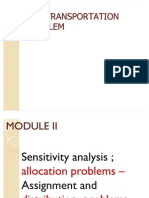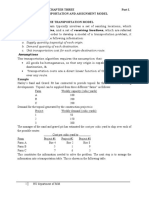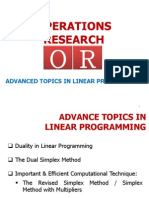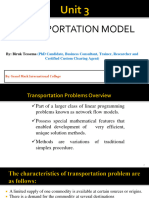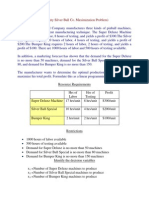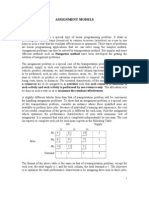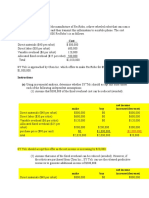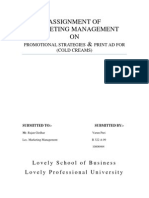Lesson Test For Optimal Solution To A Transportation Problem
Uploaded by
Bindia ChandelLesson Test For Optimal Solution To A Transportation Problem
Uploaded by
Bindia ChandelUnit 1 Lesson 16:
Test for Optimal solution to a Transportation Problem
Learning Objective:
Test for Optimality Stepping Stone Method
Before learning the methods to find the optimal solution try and practice few more questions to find the initial solution of the transportation problem. Question1 Find the initial basic feasible solution to the following transportation problem using 1)North west corner rule (NWCR) 2)Matrix Minima Method (MMM) 3)Vogels Approximation Method (VAM)
Retail shops Factories 1 2 3 Demand 1 11 16 21 200 2 13 18 24 275 3 17 14 13 275 4 14 10 10 250 Supply 250 300 400
Example 2 Find the initial basic feasible solution to the following transportation problem using 1)North west corner rule (NWCR) 2)Matrix Minima Method (MMM) 3)Vogels Approximation Method (VAM)
Destination Origin 1 2 3 1 1 4 0 2 2 3 2 3 3 2 2 4 4 0 1 Supply 6 8 10
Demand
24
Test for Optimality
Once the initial feasible solution is reached, the next step is to check the optimality. An optimal solution is one where there is no other set of transportation routes (allocations) that will further reduce the total transportation cost. Thus, well have to evaluate each unoccupied cell (represents unused routes) in the transportation table in terms of an opportunity of reducing total transportation cost.
1.Stepping Stone Method
It is a method for computing optimum solution of a transportation problem. Steps Step 1 Determine an initial basic feasible solution using any one of the following:
North West Corner Rule Matrix Minimum Method Vogel Approximation Method
Step 2 Make sure that the number of occupied cells is exactly equal to m+n-1, where m is the number of rows and n is the number of columns. Step 3 Select an unoccupied cell. Step 4 Beginning at this cell, trace a closed path using the most direct route through at least three occupied cells used in a solution and then back to the original occupied cell and moving with only horizontal and vertical moves. The cells at the turning points are called "Stepping Stones" on the path. Step 5 Assign plus (+) and minus (-) signs alternatively on each corner cell of the closed path just traced, starting with the plus sign at unoccupied cell to be evaluated. Step 6 Compute the net change in the cost along the closed path by adding together the unit cost figures found in each cell containing a plus sign and then subtracting the unit costs in each square containing the minus sign. Step 7 Check the sign of each of the net changes. If all the net changes computed are greater than or equal to zero, an optimum solution has been reached. If not, it is possible to improve the current solution and decrease the total transportation cost. Step 8 Select the unoccupied cell having the most negative net cost change and determine the maximum number of units that can be assigned to a cell marked with a minus sign on the closed path corresponding to this cell. Add this number to the unoccupied cell and to all other cells on the path marked with a plus sign. Subtract this number from cells on the closed path marked with a minus sign.
Step 9 Repeat the procedure until you get an optimum solution.
Example 3 Consider the following transportation problem (cost in rupees). Find the optimum solution
Depot Factory A B C D 4 3 3 E 6 5 9 F 8 2 6 G 6 5 5 Capacity 700 400 600 1700
Requirement 400 450 350 500
Solution: First, find out an initial basic feasible solution by Matrix Minimum Method
Depot Factory A B C Requirement D 4 3 50 3 350 400 E 6 450 5 9 450 F 8 2 350 6 350 G 6 250 5 5 250 500 Capacity 700 400 600 1700
Here, m + n - 1 = 6. So the solution is not degenerate. The cell AD (4) is empty so allocate one unit to it. Now draw a closed path from AD. Depot Factory A B C Requirement D 4 +1 3 50 3 349 400 E 6 450 5 9 450 F 8 2 350 6 350 G 6 249 5 5 251 500 Capacity 700 400 600 1700
Please note that the right angle turn in this path is permitted only at occupied cells and at the original unoccupied cell. The increase in the transportation cost per unit quantity of reallocation is +4 6 + 5 3 = 0. This indicates that every unit allocated to route AD will neither increase nor decrease the transportation cost. Thus, such a reallocation is unnecessary.
Choose another unoccupied cell. The cell BE is empty so allocate one unit to it. Now draw a closed path from BE
Depot Factory A B C Requirement D 4 3 49 3 351 400 E 6 449 5+1 9 450 F 8 2 350 6 350 G 6 251 5 5 249 500 Capacity 700 400 600 1700
The increase in the transportation cost per unit quantity of reallocation is +5 6 + 6 5 + 3 3 = 0 This indicates that every unit allocated to route BE will neither increase nor decrease the transportation cost. Thus, such a reallocation is unnecessary. The allocations for other unoccupied cells are: Unoccupied Increase in cost per unit cells of reallocation CE CF AF BG +9 6 + 6 5 = 4 +6 3 + 3 2 = 4 +8 6 +5 3 + 3 2 = 5 +5 5 + 3 3 = 0 Remarks Cost Increases Cost Increases Cost Increases Neither increase nor decrease
Since all the values of unoccupied cells are greater than or equal to zero, the solution obtained is optimum. Minimum transportation cost is: 6 * 450 + 6 * 250 + 3 * 250 + 2 * 250 +3 *350 +5 * 250 = Rs. 7350 Example 4 A company has factories at A,B and C which supply warehouse at D,E and F. Weekly factory capacities are 200, 160 and 90 units respectively. Weekly Warehouse requirement are 180, 120 and 150 units respt.. Unit shipping costs (in rupees)are as follows.
Factory A B C
D 16 14 26
E 20 8 24
F 12 18 16
Capacity 200 160 90 450
Requirement 180 120 150
Determine the optimum distribution for this company to minimize shipping cost. Solution: First, find out an initial basic feasible solution by Vogels approximation Method
Factory A B C Requirement
D 16 140 14 40 26 180
E 20 8 120 24 120
F 12 60 18 16 90 150
Capacity 200 160 90 450
Here, m + n - 1 = 5 So the solution is not degenerate. The cell AE (20) is empty so allocate one unit to it. Now draw a closed path from AD. Factory A B C Requirement D 16 139 14 41 26 180 E 20 +1 8 119 24 120 F 12 60 18 16 90 150 Capacity 200 160 90 450
The increase in the transportation cost per unit quantity of reallocation is +20 8 + 14 16 = 10. This indicates that every unit allocated to route AD will increase the transportation cost by Rs.10. Thus, such a reallocation is not included. Choose another unoccupied cell. The cell BF is empty so allocate one unit to it. Now draw a closed path from BE
Factory A B C Requirement
D 16 141 14 39 26 180
E 20 8 120 24 120
F 12 59 18 +1 16 90 150
Capacity 200 160 90 450
The opportunity cost in the transportation cost per unit quantity of reallocation is +18 12 + 16 14 = 8 This indicates that every unit allocated to route BE will increase the transportation cost by Rs. 8. Thus, such a reallocation is not included. The allocations for other unoccupied cells are: Unoccupied cells CD CE Increase in cost per unit of reallocation +26 16 + 12 16 = 6 +24 16 + 12 16 +14 8= 10 Remarks Cost Increases Cost Increases
Since all the values of unoccupied cells are greater than zero, the solution obtained is optimum. Minimum transportation cost is: 16 * 140 + 12 * 60 + 14 * 40 + 8 * 120 +16 *90 = Rs. 5,920 Example 5 Maruti Udyog Limited (MUL) produces & sells cars. It has two warehouses (A, B) and three whole sellers (1,2,3). The status at present in the warehouses is as follows: Warehouse A B Cars 40 60 Total 100
The wholesalers have placed the following order from the month: Whole seller Demand (Cars) 20 1 30 2 40 3 The transportation charges (in shipping from warehouse to the whole seller) are given below: Whole sellers Warehouse A B 2 5 (Costs in Rs. 000) 4 2 3 4
Your are required to determine the optimal number of cars to be shipped for each warehouse to each whole seller so as to minimize the total transportation costs. Example 6. Good Manufactures Limited has 3 warehouses (A, B, C) AND FOUR STORES (W, X, Y, Z). For a particular product, there is a surplus of 150 units at all the warehouse taken together, as given below: Warehouse Units of product 50 A 60 B 40 C Total 150 The transportation costs of shipping one unit of the product from warehouses to stories is given below: Stores Costs (in Rs) Warehouse Z Y X W 60 70 150 50 A 10 90 70 80 B 81 79 87 15 C The monthly requirement of the stores is as follows: Store Requirement (of product) 20 W 70 X 50 Y
10
You are required to obtain the optimal solution to the given transportation problem.
You might also like
- Sindh Mdcat Paper 2023 Code-A With Official Key70% (10)Sindh Mdcat Paper 2023 Code-A With Official Key44 pages
- MODI Method Examples Transportation Problem PDFNo ratings yetMODI Method Examples Transportation Problem PDF4 pages
- Topic 4 Transportation and Assignment Models - Chapter 950% (2)Topic 4 Transportation and Assignment Models - Chapter 964 pages
- Introduction To LP - Transshipment ProblemNo ratings yetIntroduction To LP - Transshipment Problem26 pages
- Lecture 9. Transportation and Assignment ModelsNo ratings yetLecture 9. Transportation and Assignment Models84 pages
- Introduction To Management Science 8th Edition by Bernard W. Taylor IIINo ratings yetIntroduction To Management Science 8th Edition by Bernard W. Taylor III34 pages
- Unit 7 - Distribution and Network ModelsNo ratings yetUnit 7 - Distribution and Network Models7 pages
- Transportation Problem in Operation ResearchNo ratings yetTransportation Problem in Operation Research60 pages
- Logistics Supply Chain Network Design: ManagementNo ratings yetLogistics Supply Chain Network Design: Management50 pages
- SolvedExercises Ch3 SensitivityAnalysis QuestionsNo ratings yetSolvedExercises Ch3 SensitivityAnalysis Questions5 pages
- Facility Location: Operations ManagementNo ratings yetFacility Location: Operations Management41 pages
- Microsoft PowerPoint - Transportation ProblemNo ratings yetMicrosoft PowerPoint - Transportation Problem31 pages
- Group 4: Answer Questions Number 1 To 6 Using The Given Data100% (1)Group 4: Answer Questions Number 1 To 6 Using The Given Data4 pages
- Practice: Transportation Degeneracy: Combinatorial OptimizationNo ratings yetPractice: Transportation Degeneracy: Combinatorial Optimization11 pages
- Week16 / Lecture15: Transportation Models: Special CasesNo ratings yetWeek16 / Lecture15: Transportation Models: Special Cases9 pages
- Amendment No 1 2002 To BS 7671 and Ring Circuits: BackgroundNo ratings yetAmendment No 1 2002 To BS 7671 and Ring Circuits: Background4 pages
- Sensors: Evolution of RFID Applications in Construction: A Literature ReviewNo ratings yetSensors: Evolution of RFID Applications in Construction: A Literature Review21 pages
- Promotional Strategies & Print Ad For Cold Creams100% (1)Promotional Strategies & Print Ad For Cold Creams12 pages
- Control CL Commands With Command Exit Programs - Part 1No ratings yetControl CL Commands With Command Exit Programs - Part 18 pages
- Brand Awareness & Preference Regarding Havells Green CFL PDF100% (1)Brand Awareness & Preference Regarding Havells Green CFL PDF74 pages
- Lectures 1 - 10 Introduction To Classical Mechanics: Prof. N. Harnew University of Oxford MT 2016No ratings yetLectures 1 - 10 Introduction To Classical Mechanics: Prof. N. Harnew University of Oxford MT 2016102 pages
- Performance Review Toolkit - Tools, Tips, Templates, and MoreNo ratings yetPerformance Review Toolkit - Tools, Tips, Templates, and More41 pages
- Attachment 2 GRD Request and Inquiry FormRIF 2No ratings yetAttachment 2 GRD Request and Inquiry FormRIF 22 pages
- Earthworks: Theory and Practice of Surveying Review Innovations100% (1)Earthworks: Theory and Practice of Surveying Review Innovations50 pages
- Industrial Profile: Hutti Gold Mines Company LimitedNo ratings yetIndustrial Profile: Hutti Gold Mines Company Limited78 pages
- ACCOUNTING GR12 Control Test MEMO - 13 MARCH 2025No ratings yetACCOUNTING GR12 Control Test MEMO - 13 MARCH 20255 pages
- Infection Prevention and Control (IPC) For COVID-19 VirusNo ratings yetInfection Prevention and Control (IPC) For COVID-19 Virus21 pages
- Topic 4 Transportation and Assignment Models - Chapter 9Topic 4 Transportation and Assignment Models - Chapter 9
- Introduction To Management Science 8th Edition by Bernard W. Taylor IIIIntroduction To Management Science 8th Edition by Bernard W. Taylor III
- Group 4: Answer Questions Number 1 To 6 Using The Given DataGroup 4: Answer Questions Number 1 To 6 Using The Given Data
- Practice: Transportation Degeneracy: Combinatorial OptimizationPractice: Transportation Degeneracy: Combinatorial Optimization
- Week16 / Lecture15: Transportation Models: Special CasesWeek16 / Lecture15: Transportation Models: Special Cases
- Amendment No 1 2002 To BS 7671 and Ring Circuits: BackgroundAmendment No 1 2002 To BS 7671 and Ring Circuits: Background
- Sensors: Evolution of RFID Applications in Construction: A Literature ReviewSensors: Evolution of RFID Applications in Construction: A Literature Review
- Control CL Commands With Command Exit Programs - Part 1Control CL Commands With Command Exit Programs - Part 1
- Brand Awareness & Preference Regarding Havells Green CFL PDFBrand Awareness & Preference Regarding Havells Green CFL PDF
- Lectures 1 - 10 Introduction To Classical Mechanics: Prof. N. Harnew University of Oxford MT 2016Lectures 1 - 10 Introduction To Classical Mechanics: Prof. N. Harnew University of Oxford MT 2016
- Performance Review Toolkit - Tools, Tips, Templates, and MorePerformance Review Toolkit - Tools, Tips, Templates, and More
- Earthworks: Theory and Practice of Surveying Review InnovationsEarthworks: Theory and Practice of Surveying Review Innovations
- Industrial Profile: Hutti Gold Mines Company LimitedIndustrial Profile: Hutti Gold Mines Company Limited
- Infection Prevention and Control (IPC) For COVID-19 VirusInfection Prevention and Control (IPC) For COVID-19 Virus














